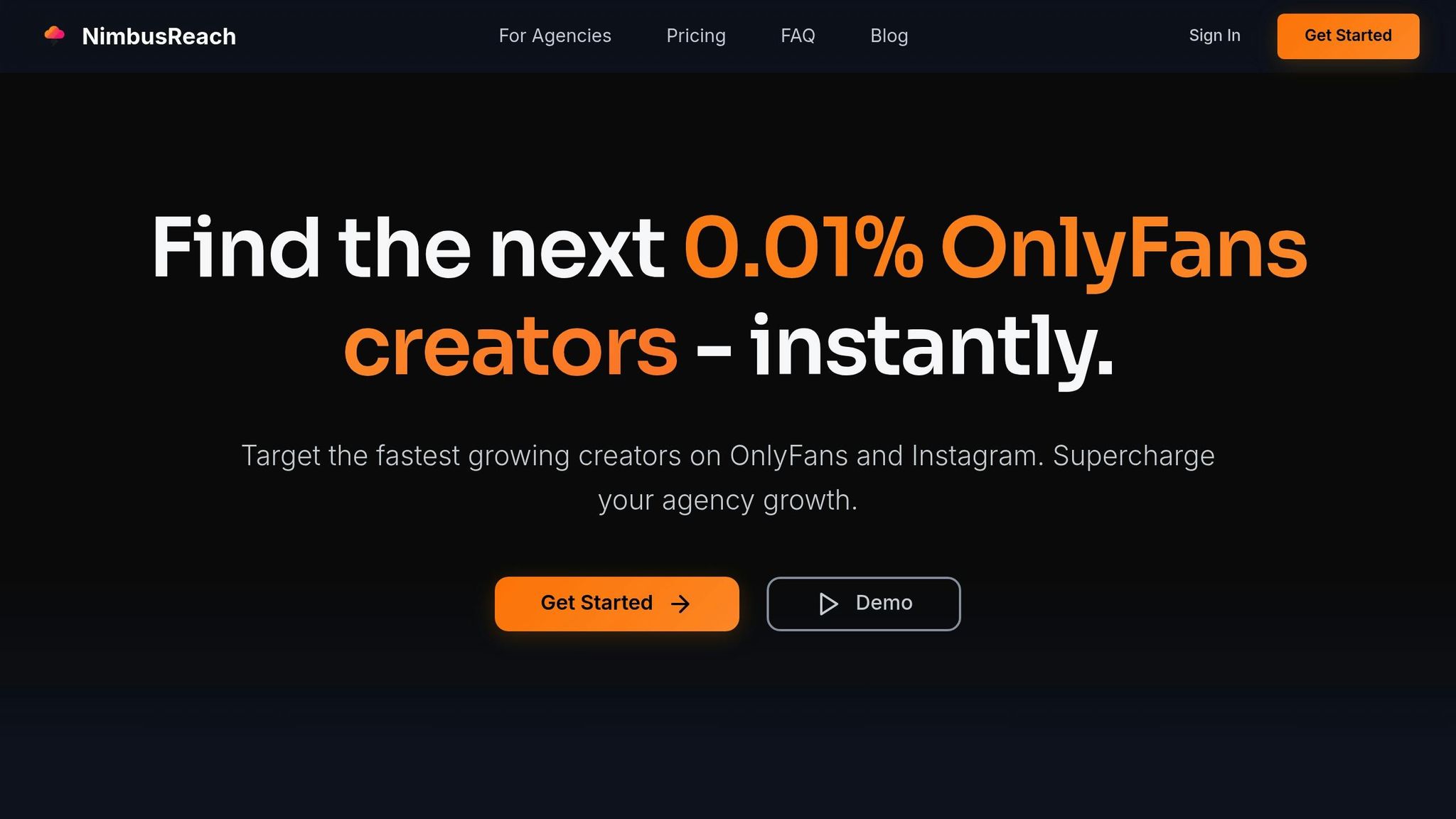The choice between concentrating on a single platform like OnlyFans or spreading creators across multiple platforms directly impacts revenue, risk, and workload. Here’s the key takeaway:
- Platform Focus: Higher earnings per creator due to specialization, simpler workflows, and platform-specific expertise. However, it comes with risks like revenue swings, algorithm changes, and regulatory issues.
- Creator Diversification: Spreads risk, ensures stable income, and helps creators reach broader audiences. But it increases management complexity, operating costs, and content adaptation challenges.
Key Stats:
- Creators on multiple platforms earn 25-40% more stable income.
- Agencies focusing on one platform see 30% higher revenue per creator but face higher risk exposure.
- Diversified portfolios reduce income volatility by up to 28%.
Quick Overview:
- Platform Focus: Streamlined processes, deeper expertise, higher revenue per creator, but high dependency risks.
- Diversification: Risk reduction, broader reach, and steady income, but higher costs and complexity.
Agencies must weigh their goals, resources, and risk tolerance to decide the best approach. Tools like NimbusReach can support either strategy by identifying top-performing creators and managing portfolios effectively.
Building a Sustainable Content Strategy with Multiple Platforms
Benefits of Platform Focus
When agencies dedicate their efforts to mastering a single platform like OnlyFans, they unlock a range of advantages that can significantly improve efficiency and profitability. This targeted approach allows teams to gain in-depth expertise, which directly translates into stronger outcomes for both the agency and the creators they support.
Streamlined Workflows and Specialized Tools
Zeroing in on one platform standardizes processes, speeds up campaigns, reduces errors, and shortens training times. For example, tools like NimbusReach simplify creator discovery with advanced search and filtering features. Agencies can quickly identify top-performing OnlyFans creators based on factors like niche, earnings, and engagement rates, cutting down hours of manual research. The platform’s proprietary Fan Devotion Score highlights creators with loyal, paying fans – making the selection process seamless. As the NimbusReach team explains:
Prospecting is the bottleneck. Finding the right creators is the hardest part – NimbusReach makes it simple.
Beyond discovery, platform-specific tools help automate repetitive tasks, streamline content scheduling, and provide detailed analytics for smarter decision-making. By focusing on mastering the unique ecosystem of a single platform, agencies can achieve a level of operational efficiency that directly enhances revenue potential.
Higher Per-Creator Revenue
Agencies specializing in one platform often see up to 30% higher average revenue per creator. This increase comes from leveraging deep platform knowledge to maximize each creator’s earning potential. For instance, understanding the intricacies of OnlyFans’ monetization tools, promotional features, and audience segmentation enables agencies to craft strategies that unlock opportunities others might overlook. This expertise leads to more effective content plans and better brand deal negotiations, backed by proven results tailored to the platform.
Additionally, most agency revenue tends to come from a small group of highly successful creators rather than a large pool of mid-tier performers. Data from Kajabi‘s 2025 report shows that creators focusing on platform-specific strategies earned up to 25% more than those spreading their efforts across multiple channels. For agencies, this translates to steadier income, stronger client relationships, and the ability to charge premium fees based on their specialized skills and results.
Simplified Content Strategy and Management
Focusing on a single platform also simplifies content creation and management. Instead of juggling multiple formats, audience demands, and platform requirements, agencies can standardize their content approach. This includes creating reusable templates, streamlining approval processes, and delivering consistent messaging that resonates with a specific audience.
Standardized workflows and platform-focused content calendars not only improve efficiency but also elevate content quality. Additionally, agencies that specialize in one platform can build stronger relationships with platform representatives. These connections often lead to early access to beta features, promotional opportunities, and dedicated support – giving agencies a competitive edge that’s hard to achieve when managing multiple platforms simultaneously.
Risks of Platform Focus
Focusing on a single platform can bring certain benefits, but it also exposes agencies to risks that can disrupt their operations. The fast-paced nature of the creator economy and the unpredictability of digital platforms make these risks especially challenging for agencies that depend heavily on one revenue source.
Revenue Swings and Algorithm Changes
When platforms like OnlyFans or Instagram tweak their algorithms, the impact can be dramatic – reducing reach by more than 30%. These changes, combined with frequent updates to content guidelines, monetization rules, and fee structures, can cut into earnings without warning. For example, the influencer market hit $21.1 billion in 2023, highlighting both the immense potential and the instability of these ecosystems. For agencies, such sudden shifts can lead to revenue shortfalls that disrupt cash flow, delay payroll, and strain relationships with their clients. Unlike traditional businesses, where market changes often happen gradually, agencies tied to a single platform can face abrupt income drops that destabilize operations in a matter of days. These algorithmic and policy shifts also create a foundation for broader regulatory and security challenges.
Regulatory and Security Risks
Relying on one platform makes agencies more vulnerable to regulatory scrutiny and security issues. Government actions or legal disputes can wipe out entire revenue streams overnight. Delayed payouts or frozen accounts can cripple cash flow, leaving agencies scrambling to meet financial obligations. On top of that, security threats like hacking and data breaches can jeopardize both creators’ safety and the agency’s ability to operate smoothly. These risks emphasize the importance of having a robust risk management strategy when managing creator portfolios.
Single-Source Revenue Problems
The financial risks tied to a single revenue source are significant. Unlike diversified portfolios, which can reduce risk by up to 30%, relying on one platform is like putting all your eggs in one basket. A single negative event – whether it’s a policy change, a platform outage, or a decline in platform popularity – can have devastating consequences for the entire operation.
For instance, technical glitches that prevent creators from posting or engaging with their audience can quickly halt income for agencies reliant on that one platform. Without alternative revenue streams, these agencies are left with no cushion to absorb the loss. This lack of diversification also stifles growth and adaptability, making it harder to respond to market changes. To put it into perspective, individual stocks tend to be twice as volatile as diversified portfolios, and the same principle applies to agencies overly reliant on a single platform.
In an industry where market conditions shift rapidly, new platforms emerge, and audience preferences evolve, agencies that depend on one platform often struggle to pivot. This lack of flexibility can hinder their recovery and long-term growth.
Benefits of Creator Spread
Relying heavily on a single platform can leave creators and agencies vulnerable, but spreading creators across multiple platforms offers a smart way to mitigate risks while unlocking new growth opportunities. This multi-platform approach provides advantages that single-platform strategies simply can’t deliver.
Risk Reduction and Revenue Stability
Diversifying where creators operate is a lot like diversifying an investment portfolio – it helps balance out the highs and lows of the creator economy. Creators active on three or more platforms report earning up to 40% more stable monthly income compared to those relying on just one platform. By spreading risk, creators can better protect their earnings and avoid devastating losses.
In 2023, FanFinder used NimbusReach to identify OnlyFans creators who had strong engagement on Instagram. By helping these creators expand their content to both platforms, FanFinder saw a 35% increase in average monthly revenue per creator and a 28% drop in income volatility over six months.
When one platform experiences disruptions – whether from technical glitches, policy changes, or algorithm updates – creators with a presence on multiple platforms can maintain their income streams. This "safety net" effect allows agencies to navigate challenges that might cripple competitors focused solely on one platform. Diversified portfolios also tend to recover more quickly from market downturns and experience less volatility overall, offering the consistency needed for long-term growth. This stability paves the way for reaching new audiences and expanding influence.
Broader Audience Reach
Every platform has its own unique audience, and smart agencies use these differences to help creators reach more people. TikTok, for instance, attracts a younger demographic, while Instagram and YouTube cater to a wider age range. This allows creators to build diverse fan communities. Having a presence across multiple platforms also creates opportunities for followers on one platform to become paying subscribers on another.
Brands are increasingly drawn to creators with diversified audiences because they provide access to multiple market segments and tend to drive stronger engagement. Additionally, platform diversification can help creators grow their international fan bases, reaching audiences across different regions more effectively.
Cross-Platform Revenue Opportunities
Reaching a broader audience naturally opens doors to more ways of earning. Each platform offers unique monetization tools – like Instagram’s shopping features, OnlyFans’ subscription model, and TikTok’s brand partnership programs – that creators can use to generate income from sponsorships, merchandise, and even new formats like podcasts or newsletters. Repurposing content across platforms also boosts the return on investment for content creation, as creators can tailor their work to fit each platform’s audience.
A strong presence across multiple platforms also gives creators more leverage when negotiating with brands. Those who can offer bundled exposure across different channels can command higher rates. For agencies, identifying these high-performing, multi-platform creators becomes essential. Tools like NimbusReach make this easier by analyzing engagement trends across platforms like OnlyFans and Instagram, helping agencies make data-driven decisions about where to allocate resources and how to support creators’ growth effectively.
Challenges of Creator Spread
Diversifying revenue streams can be a smart move, but it comes with its own set of headaches. For agencies managing creators across multiple platforms, the operational demands can quickly spiral. Here’s a closer look at the key obstacles they face when juggling a diversified creator portfolio.
Increased Management Complexity
Handling creators on multiple platforms is no small feat. Each platform has its own set of rules, content formats, and schedules, forcing agencies to constantly tweak their strategies . This juggling act often requires hiring specialized staff, implementing advanced project management tools, and staying on top of relentless platform updates . As if that weren’t enough, even a single algorithm change can derail an entire month’s carefully planned strategy, creating workflow bottlenecks that slow everything down.
Higher Operating Costs
Expanding to multiple platforms doesn’t just complicate operations – it also drives up expenses. Agencies often need to invest in a range of analytics tools, scheduling software, and platform-specific advertising solutions. On top of that, hiring experts like platform specialists, community managers, and content creators to meet each platform’s unique demands can significantly inflate payroll costs. The need for advanced tools to ensure consistent quality and performance only adds to the financial burden .
Content Adaptation Across Platforms
Creating content that works across different platforms is another major hurdle. Each platform demands a unique approach. For example, Instagram thrives on visually appealing, short-form content, while OnlyFans focuses on longer, more explicit material with direct monetization options. This means agencies often need to create entirely separate assets for each platform and conduct compliance checks to meet varying guidelines. Adapting to these differences, while also keeping up with audience expectations, adds another layer of complexity to the process.
To tackle these challenges, tools like NimbusReach can be a game-changer. By offering advanced search, filtering, and analytics, NimbusReach helps agencies identify top-performing creators on platforms like Instagram and OnlyFans. Features such as the Fan Devotion Score and detailed performance metrics allow agencies to allocate resources wisely and focus on creators with dedicated superfans. This way, they can navigate the complexities and manage costs more effectively.
sbb-itb-bd3d2dc
Platform Focus vs. Creator Spread: Direct Comparison
Agencies face a critical decision: should they zero in on a single platform or spread their efforts across a variety of creators and channels? This choice boils down to balancing the potential for high revenue against the need for stability. Here’s a closer look at how these two strategies stack up.
Revenue dynamics highlight a key difference. Agencies that specialize in one platform often see higher earnings per creator. By honing in on specific tools and understanding how audiences behave on that platform, they can maximize revenue opportunities. The "power-law earnings" principle backs this up – most agency revenue typically comes from a small group of top-performing creators with loyal superfans. On the other hand, agencies with a diversified creator portfolio prioritize steady income over peak earnings. While individual creator revenue may be lower, the overall income is more stable and less vulnerable to sudden disruptions.
The risk landscape also varies significantly. Relying on a single platform can leave agencies exposed to major risks, like sudden account suspensions or policy changes that can sharply cut revenue. Diversifying across multiple channels spreads this risk, ensuring that setbacks on one platform don’t derail the entire operation.
Operational demands differ as well. A platform-focused approach simplifies daily management with streamlined workflows and a unified content strategy. This allows agencies to invest deeply in tools and expertise tailored to that one platform. In contrast, a diversified approach requires juggling multiple platforms, content types, and creators, which demands advanced project management skills and broader expertise.
Comparison Table
| Aspect | Platform Focus | Creator Spread |
|---|---|---|
| Revenue Potential | High, leveraging platform-specific expertise and targeting top 0.01% creators | Moderate, but more stable across varied income streams |
| Risk Exposure | High, due to dependence on a single platform and vulnerability to policy changes | Lower, thanks to diversified revenue sources |
| Operational Complexity | Lower, with streamlined workflows and unified strategies | Higher, requiring management of diverse platforms and content types |
| Scalability | Limited by platform growth and policy constraints | Broader, with opportunities across multiple platforms |
| Long-term Sustainability | Riskier if platform policies or market conditions shift | More resilient to industry changes and disruptions |
| Resource Requirements | Focused investment in platform-specific tools and expertise | Distributed investment across multiple systems and skills |
Both strategies have their merits, depending on an agency’s goals. According to Kajabi’s 2025 report, entrepreneurial creators with diversified portfolios earned 25% more on average than social-first creators. They also reported better financial and mental well-being. Meanwhile, independent creator-owned media companies saw 20% year-over-year revenue growth by reducing their reliance on single platforms.
Tools like NimbusReach can support agencies regardless of their chosen strategy. For platform-focused agencies, NimbusReach helps pinpoint top-performing creators on platforms like OnlyFans and Instagram, focusing on those with loyal, paying fans. For agencies pursuing a diversified model, it simplifies talent discovery and management across multiple platforms, enabling smarter, data-driven decisions at scale.
The decision ultimately comes down to measurable trade-offs. Agencies with deep expertise and a higher tolerance for risk may thrive with a platform-focused approach. Those seeking stability and long-term resilience might find diversification the better path. Tools like NimbusReach can enhance either strategy, helping agencies make the most of their chosen direction.
Decision Framework for Agencies
Choosing between focusing on a single platform or diversifying across multiple platforms isn’t a decision to take lightly. Agencies must carefully consider their current standing, available resources, and long-term objectives. This framework outlines how to strike the right balance between managing risk and pursuing growth.
Portfolio Assessment and Risk Tolerance
Start by analyzing your creator portfolio and revenue sources. If more than 60% of your income comes from a single platform, you’re in a high-risk position. This level of dependency makes you vulnerable to sudden policy changes, algorithm updates, or platform outages that could drastically impact your revenue overnight. Another critical factor is your access to your audience – do you have direct communication channels like email lists or phone numbers? If not, and you rely heavily on platform-provided analytics, your agency may be at greater risk of being blindsided by changes.
Your financial stability also plays a significant role in determining your risk tolerance. Agencies with strong cash reserves and diversified income streams are better equipped to handle the unpredictability of a platform-centric strategy. On the other hand, if your margins are slim, leaning toward diversification can help mitigate sudden revenue drops. Experts suggest that no more than 50–60% of your agency’s income should be tied to a single platform. Regularly reviewing your portfolio with a checklist that includes contingency plans for platform disruptions can help you maintain a diversified revenue stream and anticipate potential challenges.
Once you have a clear understanding of your risk profile, you can allocate resources to support the strategy that aligns with your goals.
Resource Alignment and Market Position
Your team’s expertise and operational capacity will heavily influence which strategy suits you best. A platform-focused approach requires deep knowledge of specific tools, audience behaviors, and content strategies tailored to that platform. If your team already excels in these areas, doubling down on a single platform might yield the highest returns on your investment.
On the flip side, diversification demands a broader skill set. You’ll need systems for managing content across multiple platforms, tracking analytics from different channels, and ensuring smooth communication between team members and creators. Agencies capable of offering comprehensive talent management across platforms can attract a wider range of creators but must also invest in the necessary tools and expertise to handle the complexity.
Consider whether your agency should specialize in a niche or provide a full-service approach. Niche specialization can help you command higher fees and attract top-tier creators, but it also comes with the risk of being overly reliant on a single platform. Meanwhile, aligning your tech stack with integrated SaaS tools can streamline operations, reduce administrative tasks, and improve tracking of performance across platforms.
Using Tools Like NimbusReach

Data-driven tools can simplify these assessments. For instance, NimbusReach provides valuable insights for both platform-focused and diversified strategies. Its proprietary Fan Devotion Score helps identify creators with engaged, paying audiences – an essential metric whether you’re scouting breakout stars for a single platform or stable performers for a diversified portfolio.
For platform-focused agencies, NimbusReach offers advanced filters to identify elite OnlyFans creators who can serve as key revenue drivers. Since most agency earnings come from a small number of top-performing creators, finding these high-impact individuals is crucial.
For those pursuing diversification, NimbusReach also delivers cross-platform insights. These features allow you to identify creators who have successfully transitioned between platforms or demonstrate potential across multiple channels. Growth alerts and notifications can help you spot rising talent early, giving you a competitive edge before these creators become saturated with agency offers.
Hybrid Approaches and Best Practices
Hybrid strategies combine platform expertise with a broader approach to minimize risk and seize new opportunities. By focusing on their main platform while strategically branching out, agencies can achieve a balance between specialization and diversification.
Tiered Portfolio Management
A smart hybrid approach involves grouping creators into tiers based on their contribution to your agency’s revenue. This method, rooted in earlier risk assessments, divides creators into core and satellite tiers. Typically, agencies dedicate about 70-80% of their resources to core creators and 20-30% to satellite creators, ensuring a balance between focus and diversification.
The core tier includes creators who dominate on the primary platform and significantly drive revenue. These creators receive the most attention, resources, and specialized tools. Since a small number of top-performing creators often generate the majority of revenue, prioritizing their growth is essential.
The satellite tier features creators who work across secondary platforms. These creators are managed with more standardized processes and less intensive support. Mid-tier creators earning $5,000–$15,000 monthly are often ideal for this group. They already have loyal audiences but still have room to grow by expanding to other platforms.
Decisions about creator placement should rely on data, not intuition. For the core tier, focus on creators with exceptional metrics, such as high fan devotion scores, consistent revenue growth, and strong engagement rates. For the satellite tier, look for creators with flexible content styles, broad appeal, and audiences that span multiple demographics – qualities that make them well-suited for platform diversification.
Content Repurposing Across Platforms
Efficient content strategies are critical for maximizing hybrid benefits. A "create once, distribute many" approach allows you to repurpose core content for different platforms, cutting production time by 60-70% compared to creating unique content for each platform.
Start by creating pillar content that can be adapted. For example, a single photoshoot can yield exclusive content for OnlyFans, teaser images for Instagram, short-form videos for TikTok, and behind-the-scenes posts for Twitter. The key is tailoring the content to each platform’s format and audience preferences rather than simply duplicating it.
To streamline this process, set up modular content libraries for quick adaptation. Define workflows with clear editing guidelines, optimal posting schedules, and systems to track performance. This will help identify which types of repurposed content resonate best on each platform.
Structure your team to include platform specialists for core creators and generalist account managers for satellite-tier talent. Regular strategy meetings can help refine these processes and ensure alignment.
Risk Management and Backup Planning
Hybrid strategies are incomplete without robust risk management. Protecting against platform disruptions requires multiple safeguards. Start by building direct audience channels like email lists, SMS campaigns, or proprietary apps. These channels ensure continued access to your audience, even if a platform changes policies or goes offline.
Diversify your revenue streams to reduce reliance on any one platform. A good rule of thumb is to ensure no single platform accounts for more than 60-70% of your total revenue. Back up all creator content, audience data, and financial records on secure, platform-independent storage systems.
Prepare for disruptions with contingency plans. These should include steps to handle sudden policy changes, account suspensions, or platform shutdowns. Identify alternative platforms where audiences can be redirected, pre-plan communication strategies for fans, and explore backup monetization options.
Financial reserves are also crucial. They provide stability during platform transitions, giving agencies time to rebuild audience connections elsewhere. Quarterly portfolio reviews are a good practice to ensure creators are in the right tiers and that resources are allocated effectively based on performance data.
Tools like NimbusReach can further enhance hybrid strategies. Its growth alerts and notifications help agencies identify rising talents early, giving them a competitive edge. For diversification efforts, NimbusReach offers cross-platform insights, making it easier to spot creators who have successfully transitioned between platforms or show potential across multiple channels.
Conclusion: Choosing the Right Path for Long-Term Growth
Deciding between sticking to a single platform or branching out into multiple depends entirely on your agency’s goals, available resources, and appetite for risk. For smaller agencies or those just starting out, focusing on one platform might make sense – it allows for a more concentrated effort. On the other hand, established teams with more resources can explore diversification to minimize risk and tap into a wider range of opportunities.
The most effective agencies rely on hard data – performance metrics, audience insights, and revenue figures – to shape their strategies. This data helps identify which creators deliver results and which platforms generate the best return on investment (ROI).
Tools like NimbusReach play a crucial role in supporting both focused and diversified strategies. With its advanced analytics and Fan Devotion Score, agencies can zero in on creators who have loyal, paying audiences. Since a significant portion of agency revenue often comes from a small group of top-performing creators, having access to detailed performance data and growth forecasts is essential for making smart partnership decisions.
By using this data, agencies can craft practical, balanced strategies. For example, a hybrid approach – investing heavily in a core group of creators while experimenting with a broader pool of talent – combines the benefits of specialization with the flexibility needed to weather platform changes and algorithm shifts.
It’s also important to remember that strategies should evolve with your agency. What works for a startup might not be scalable for a larger operation. Regularly reviewing your portfolio and assessing performance ensures your approach stays aligned with your business objectives.
As the creator economy continues to shift, the agencies that succeed will be those that adapt quickly. Strategic planning, innovation, and ongoing performance monitoring will be the keys to achieving sustainable growth in an ever-changing landscape.
FAQs
What should agencies consider when choosing between focusing on a single platform or working with a diverse range of creators?
When agencies are weighing a platform-focused strategy against diversifying their creator portfolio, there are a few key factors to keep in mind. These include the specific niche or industry, potential earnings for creators, engagement rates, and the quality of the audience each creator attracts. Paying close attention to these elements helps identify creators who can deliver stronger results.
Choosing diversification can help agencies spread their risk by avoiding over-reliance on a single platform while reaching a broader range of audiences. On the flip side, concentrating efforts on one platform allows for more focused campaigns and potentially higher returns within that space. To make informed decisions, agencies should leverage tools that offer in-depth analytics, audience insights, and performance metrics. These tools are invaluable for spotting creators with loyal and authentic followings. The best approach ultimately hinges on the agency’s specific objectives and growth plans.
What strategies can agencies use to handle the challenges and costs of working with creators across multiple platforms?
Managing creators across multiple platforms can be a daunting task for agencies, but data-driven tools offer a way to simplify the process. Platforms like NimbusReach make it easier to find creators who have real, paying fans by using advanced filters and analytics. This ensures agencies focus their efforts on opportunities that truly matter.
Spotting rising and top-performing creators early can lead to better returns on investment while cutting down on unnecessary expenses. With access to detailed performance metrics and audience engagement data, agencies can make smarter decisions, allocate budgets more effectively, and reduce the risks that come with relying too heavily on one platform. This strategy doesn’t just cut through the complexity – it also helps unlock greater revenue potential.
How can data-driven decisions help agencies choose between focusing on a single platform or diversifying their creator portfolio for long-term success?
Data-driven decision-making plays a crucial role in helping agencies balance the risks of relying too heavily on a single platform and the advantages of spreading their efforts across multiple channels. By diving into metrics like earnings, audience engagement, and growth patterns, agencies can make smarter, goal-oriented decisions.
Tools such as the Fan Devotion Score offer valuable insights by pinpointing creators with loyal, paying followers. This allows agencies to zero in on top-performing creators and craft strategies that align with their objectives – whether that means maximizing results on one platform or building a diverse creator portfolio for long-term stability.





